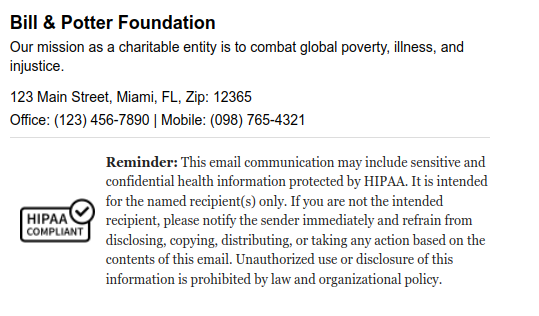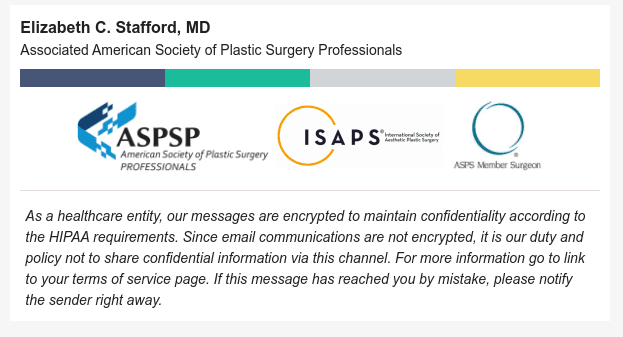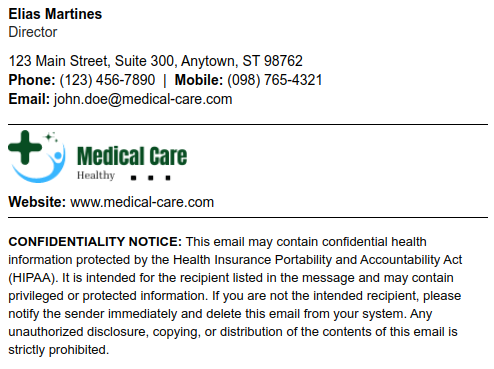This post is also available in: Português
Maintaining HIPAA compliance is incredibly important for anyone working in the healthcare industry. One of the most effective ways to do this is with a HIPAA-compliant email signature.
These signatures use a HIPAA email disclaimer to flag and protect confidential information. Setting up a disclaimer block in your email signature is easy, and it can help protect you and your patients.

Here’s what you need to know about HIPAA compliance in email signatures and how to apply it.
Introduction to HIPAA and its importance
HIPAA stands for the Health Insurance Portability and Accountability Act, an important piece of United States legislation focused on the healthcare industry.
HIPAA addresses several important aspects of healthcare, with a main focus on safeguarding individuals’ Protected Health Information (PHI). It is important because it ensures the confidentiality, integrity, and availability of sensitive health data.
If you run a business in the field of healthcare, then protecting patients’ privileged and confidential information is essential.
Why is a HIPAA disclaimer necessary for emails?
HIPAA disclaimers in emails alert recipients about the confidentiality of the information contained within the email. See another example of an email signature with a disclaimer area.

However, check whether you need to use a disclaimer in your HIPAA-compliant email.
Protects PHI
HIPAA mandates the protection of Protected Health Information (PHI). When healthcare professionals or organizations communicate via email, they might inadvertently include PHI.
A disclaimer acts as a warning to recipients that the email might contain confidential health information and should only be accessed by the intended recipient. This helps protect confidential data, and it shows patients that the healthcare professional cares about HIPAA law.
Legal compliance
HIPAA requires relevant healthcare organizations to take necessary measures to protect PHI.
While email is a common mode of communication, it’s not entirely secure. Including an external email disclaimer emphasizes the confidential nature of the information and notifies the recipient about their responsibility in case the wrong person receives the email.
Mitigating risks
Including a HIPAA disclaimer can help mitigate potential risks in case of accidental disclosure of PHI.
If an unauthorized person accesses the email, the disclaimer serves as evidence that the sender took reasonable steps to protect the information.
Including a HIPAA email disclaimer is easy to do, and it can go a long way in offering legal protection in the case of legal action.
Educational purpose
A HIPAA email disclaimer also serves an educational purpose, reminding employees and recipients about the sensitivity of health-related information and the need for caution when handling such data.
Reminding people about the confidential information that they work with each day is always a good idea.
Organization’s policy
Many healthcare organizations have internal policies that require them to use a HIPAA email signature disclaimer.
This ensures uniformity and consistency in sticking to HIPAA regulations across all communications sent by the organization.
HIPAA email disclaimer examples
There are various types of HIPAA email disclaimer examples you could use. To help you create your email signature, here are a few examples.
These examples of HIPAA disclaimer text are designed as templates. You can adjust and customize them based on the specific requirements and policies of your organization.
Basic disclaimer
“This email may contain confidential health information protected by the Health Insurance Portability and Accountability Act (HIPAA). It is intended for the recipient listed in the message and may contain privileged or protected information. If you are not the intended recipient, please notify the sender immediately and delete this email from your system. Any unauthorized disclosure, copying, or distribution of the contents of this email is strictly prohibited.”
Email signature example with the basic HIPAA section:

Notification and disclaimer
“Notice: This email and any attachments may contain confidential health information protected by federal and state laws. It is intended solely for the use of the individual or entity named as the recipient. If you are not the intended recipient, please notify the sender and delete this email immediately. Any unauthorized review, use, dissemination, distribution, or copying of this email and its contents is strictly prohibited and may be unlawful.”
Policy reminder disclaimer
“Reminder: This email communication may include sensitive and confidential health information protected by HIPAA. It is intended for the named recipient(s) only. If you are not the intended recipient, please notify the sender immediately and refrain from disclosing, copying, distributing, or taking any action based on the contents of this email. Unauthorized use or disclosure of this information is prohibited by law and organizational policy.”
Confidentiality statement
“Confidentiality Notice: This email message, including any attachments, may contain confidential health information intended solely for the named recipient(s). If you have received this email in error, please notify the sender immediately and delete this message from your system. Any unauthorized disclosure, distribution, or use of the information contained herein is strictly prohibited and may be subject to legal consequences.”
Using HIPAA disclaimers in different email scenarios
There are various situations where emails need to be HIPAA-compliant. Adding a HIPAA disclaimer to emails in the following scenarios makes recipients aware of confidential information and their responsibility to protect it.
It’s always a good idea to incorporate HIPAA disclaimers as a standard practice for any of these types of communications.
Here are a few examples of when to use a HIPAA email disclaimer.
Sending patient information to healthcare providers
When a healthcare professional sends patient information to another healthcare provider for consultation or referral, including a HIPAA disclaimer is essential. This could include sending test results or treatment plans.
Communicating with patients
Including a HIPAA disclaimer is important in any emails sent to patients that contain their:
- health records
- appointment reminders
- any other medical information
Internal communications within healthcare organizations
Employees could exchange emails discussing patient cases, treatment plans, or administrative matters within a healthcare organization.
Add a HIPAA email disclaimer to these messages to remind employees about the confidentiality of the information being shared and why you need to keep it protected.
Correspondence with business associates
When healthcare providers communicate with their business associates, like insurance companies or medical suppliers, using a HIPAA disclaimer is important if they share patient-related information.
All parties must understand the confidentiality requirements of this information and their need to protect it. A good HIPAA disclaimer helps you achieve this.
Educational and training materials
Include a HIPAA disclaimer in any emails containing educational materials or training sessions related to handling PHI. This reminds recipients of the importance of confidentiality and proper handling of this sensitive data.
Response to patient queries or requests
Incorporate a HIPAA disclaimer when replying to patient inquiries or requests for their health information.
Doing so reassures patients about the confidentiality of their communication and how their information is protected. This is essential for maintaining a professional and reputable reputation as a healthcare professional.
Adding HIPAA to your branded email signature
Including a HIPAA banner or logo in your branded email signature can be an effective way to remind employees, customers, and partners about your commitment to protecting health information.
This reinforces your organization’s commitment to protecting sensitive health information and reminds recipients about the importance of handling such information with care and confidentiality.
You can easily create this using an email signature generator that includes customizable templates for email disclaimers and company branding.
Conclusion
HIPAA-compliant email disclaimers are easy to set up and manage with the right tool. When you add them to your email signature, they add valuable protection to your patients’ information and your reputation. As a healthcare professional, sticking to these standards is essential.

Create your first email signature with Bybrand
Bybrand offers the ability to generate, administer, and distribute essential email signatures for your employees.